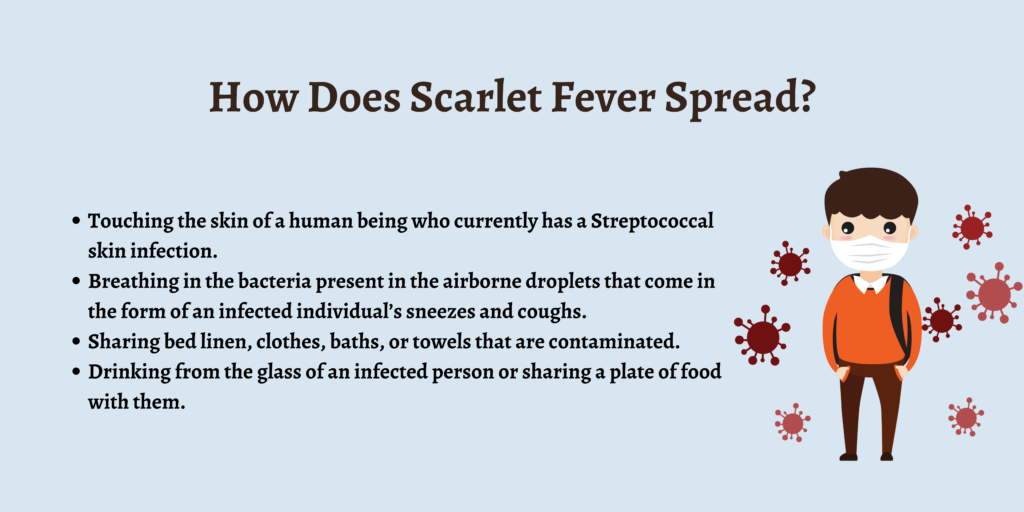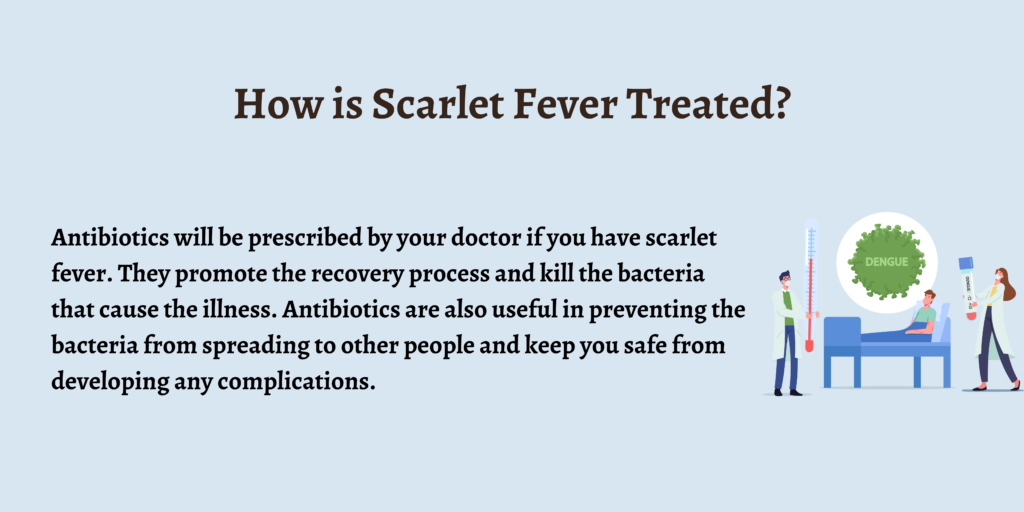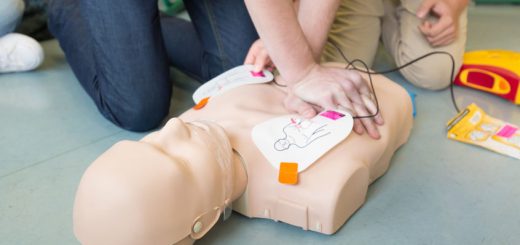What is Scarlet Fever?
Scarlet fever is a bacterial illness that occurs due to Group A Streptococcus, which can be found in a human being’s throat and on the skin. The same bacteria also cause people to have strep throat.
Also known as scarlatina, a poison is created by the bacteria that leads to a bright red rash spreading all over the body, which is where the illness gets its name from. Since the rash is bumpy, it is also often referred to as a sandpaper rash.
Once an individual gets affected by scarlet fever, resorting to antibiotic treatments early on can help in decreasing the severity of the symptoms and also promote quick recovery.
In this article, we will be discussing the symptoms of scarlet fever, how it spreads, how to prevent it, and much more.
What Causes Scarlet Fever?
Scarlet fever is caused by a toxin that certain strains of streptococcal bacteria release when they infect the upper respiratory tract. It passes from person to person the same way strep throat does—through close contact between an infected and a noninfected person. When a child with the infection coughs or sneezes, bacteria-laden droplets are expelled. Children playing face to face, eating together, and sharing toys and eating utensils can easily pass strep infections back and forth.
What are the Symptoms of Scarlet Fever?
The symptoms of scarlet fever include:
- A red rash that begins on the neck or face and spreads to the legs, arms, and back.
- The area around the mouth turns pale.
- The folds of skin around the neck, knees, elbows, armpits, and groin turn a darker shade of red.
- The face looking flushed.
- A bumpy and red tongue that has a white coating.
- Difficulty swallowing.
- Sore and swollen throat and tonsils.
- Vomiting and nausea.
- Abdominal pain
- Fever
- Loss of appetite.
- Headache
- Muscle and body aches.
- Chills.
What is Scarlet Fever Tongue?
A swollen tongue that is bumpy and red is one of the signs of scarlet fever. It’s often also known as strawberry tongue since it looks like a strawberry.
Who Gets Affected by Scarlet Fever?
Although scarlet fever can affect people of all age groups, it’s most commonly seen among kids between the ages of 5 to 15.
How Does Scarlet Fever Spread?

Scarlet fever is extremely infectious, and this is how it can spread:
- Touching the skin of a human being who currently has a Streptococcal skin infection.
- Breathing in the bacteria present in the airborne droplets that come in the form of an infected individual’s sneezes and coughs.
- Sharing bed linen, clothes, baths, or towels that are contaminated.
- Drinking from the glass of an infected person or sharing a plate of food with them.
What Does Scarlet Fever Rash Look Like?
Scarlet fever rash usually begins in the form of flat and small splotches on a person’s skin and gradually turns into bumps. The rash can also give the appearance of a terrible sunburn, and the texture mostly feels like sandpaper.
Who is At Risk for Scarlet Fever?
While the risk of developing scarlet fever is present among everyone, it is mostly seen in children who fall under the age group of 5 to 15. The risk is higher for parents and adults who are constantly in contact with children in this age range.
It’s not very common in toddlers and babies. Coming in contact with an infected person, being in large group settings, and being exposed to outbreaks in various communities or neighborhoods can amplify your risk of developing scarlet fever.
What are the Complications of Scarlet Fever?
While complications from scarlet fever are not too common, they can happen. The ones to know about are as follows:
- Sinus infections
- Kidney damage
- Arthritis
- Ear infections
- Meningitis
- Pneumonia
- Mastoiditis (caused due to a middle ear infection)
- Rheumatic fever
- Abscesses around the brain or tonsils
- Blood poisoning
How is Scarlet Fever Diagnosed?
When you visit a doctor regarding scarlet fever, they will ask you about your symptoms and conduct a physical examination. The diagnosis could involve:
- A rapid strep test that collects a throat swab specimen and tests the sample to determine if the group A strep bacteria is the reason for the illness.
- A throat culture could be done if the rapid strep test returns negative. It takes 24 to 48 hours to determine if the bacteria are causing the illness.
- Your doctor could also recommend a rapid molecular strep test to detect the presence of strep throat.
How is Scarlet Fever Treated?
Antibiotics will be prescribed by your doctor if you have scarlet fever. They promote the recovery process and kill the bacteria that cause the illness. Antibiotics are also useful in preventing the bacteria from spreading to other people and keep you safe from developing any complications.
Since a swollen and sore throat is one of the symptoms of scarlet fever, children can find it difficult to swallow their food if they have scarlet fever. In such cases, parents should feed them liquids and soft foods. Make sure to also keep them hydrated.
Over-the-counter pain medications such as ibuprofen can also work but do check with your doctor first before consuming them or giving them to your child.
How to Avoid Spreading Scarlet Fever?
When an adult has scarlet fever, they should stay away from their workplace for at least a period of 24 hours after beginning the treatment. If a child develops scarlet fever, parents should ensure not to send them to school for 24 hours once their antibiotic treatment begins.
How to Prevent Scarlet Fever?
Here is how you can prevent yourself from getting scarlet fever:
- Stay away from the individuals infected by scarlet fever.
- Cover your nose and mouth while sneezing and coughing.
- Wash your hands thoroughly and teach your child how to do so as well. In case water and soap are not available, go for an alcohol-based sanitizer.
- Don’t share food or utensils with other people.
- If a person in the family has been infected with strep, remember to keep their toothbrush separate from the ones used by other family members.
Should I Seek Medical Attention?
Yes. It is important to get an accurate diagnosis of strep infections and scarlet fever, since many other conditions can cause similar symptoms. If a strep infection is present, antibiotic therapy is necessary to prevent complications, such as rheumatic fever.
Never delay in seeking professional medical help for your child.
When to Contact a Healthcare Provider for Scarlet Fever?
If you or someone in your family develops a rash, you should get in touch with your healthcare provider. It is also vital to contact them if you witness signs of scarlet fever, such as swollen glands, sore throat, or fever.
Once you start taking antibiotics, you will know it’s time to call your doctor if:
- Your symptoms don’t get better after the 24-hour period of initiating the treatment.
- You experience new symptoms or worsening ones after beginning the treatment.
FAQs
1. What are the symptoms of scarlet fever?
Some of the symptoms of scarlet fever are a bumpy tongue, fever, chills, abdominal pain, and aches in the body.
2. How does one get scarlet fever?
One can get scarlet fever by breathing in the droplets, sneezed or coughed out by an infected individual, or by sharing plates and glasses with them.
3. When to call a doctor for scarlet fever?
If you have scarlet fever, call your doctor if the symptoms get worse or if new symptoms develop. Get in touch with them if you witness the symptoms of scarlet fever coming on so you can get diagnosed.
4. Is scarlet fever more common in children?
Yes, scarlet fever is more common in children.
5. How to prevent scarlet fever?
The ways to prevent scarlet fever include covering your mouth and nose, washing your hands thoroughly, and not sharing food or utensils.
Conclusion
Scarlet fever used to be a severe and common illness during the early 20th century, especially among children. However, it became treatable owing to the advancements in the field of medicine. It can, however, cause major health problems if left untreated.
Being able to diagnose scarlet fever is not difficult, which is why you should follow the treatment plan given to you by your doctor as soon as you’re diagnosed with it. Just ensure to alert your healthcare provider the minute you start noticing the symptoms so that your treatment doesn’t get delayed.







